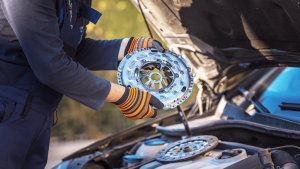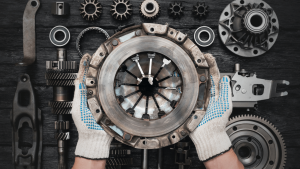Do you know the best thing about cars? Like our body, every part of the car aligns with other parts and helps the other parts smooth functioning. In this blog we are providing you a definitive guide about car clutch. When every part of a car perfectly aligns with other parts, it enables ease of performance.
For example, the steering wheel, primarily responsible for rotating tyres, also possesses several other functions and is used for blowing the horn, giving indications, and controlling the radio and sound system. Like the steering wheel, there are other indispensable parts of a car without which it cannot operate. One such part is the car clutch.
To be clear, here we will only talk about the non-automated cars that use a manual transmission. In manual transmission cars, the car makers install the clutch as a pedal along with brake and accelerator pedals.
Read our blog on car clutch, to understand the working and importance of a car clutch. Read along to find out more.
Are You Aware Of What A Clutch Is?

A Clutch as we all know is a mechanical device. It acts as a linkage between the car’s engine and its transmission system. It connects and also disconnects the engine with the transmission system using two rotating shafts in a manner that they transmit power from one shaft to another.
The two shafts of clutches are very valuable. One acts as a drive shaft, and the other acts as a driven shaft. These shafts allow the clutch to engage and disengage power from the engine crankshaft to transmission. When you push the clutch pedal it disengages the engine from the transmission system and assists in the gear shift.
In simple words, clutches enable drivers to change gears smoothly. You must press the clutches to shift from one gear to another.
Let us now understand some essential components of a clutch that enable a clutch to operate smoothly.
A car clutch typically comprises a clutch plate, pressure plate, and flywheel, which collectively help in the smooth and effective running of the clutch. While the flywheel connects to the car’s engine, the clutch plate connects with the car’s transmission. Let us now learn a bit about these components:
Clutch Plate:
It is the rotating part of the clutch to which frictional material is attached.
Flywheel:
Its primary function is to assist the engine rotation. The flywheel connects with the engine crankshaft, so it spins when the engine is running.
Pressure plate:
The pressure plate is fixed to the flywheel and rotates along with the flywheel. It is a critical part of the entire clutch assembly.
With the help of springs, the pressure plate pushes against the clutch plate. As the name suggests, the pressure plate applies pressure to hold the driven friction disk between it and the flywheel.
What Role Does A Clutch Have?

As mentioned above, the clutch helps the power flow from the engine to the wheel through the transmission system.
The clutch plays a very significant role in running the whole car. As recommended only choose a professional mobile mechanic for the servicing of your clutch.
We need a clutch in the car because the engine is constantly working even when the wheels/tires aren’t. We must disconnect the wheel from the engine to stop the car without affecting the engine. When trying to stop your car, the engine is trying to propel it forward while the brake is trying to stop it altogether. Pressing the clutch and the brake together will disengage the gearbox from the wheels, allowing the wheels to move independently of the engine. This will slow down the car’s speed, and it will eventually come to a halt.
The clutch also helps the driver to shift the gears smoothly. However, it is essential to understand when you should press the clutch. If your car speed is less, you must press the clutch first, followed by the brake. For sudden braking, you must press both clutch and brake together. However, if you are driving at high speed, you must first push the brake, followed by the clutch.
How does the clutch work?

A Clutch allows power transmission and controls the need for motion in a car. A clutch is generally attached to the two moving shafts, in which one shaft is connected with the engine or the power unit while the other releases the power. The clutch connects these two shafts so they can couple up and spin together at the same speed or get decoupled and spin at different speeds.
When you are driving your car, and your foot is not on the clutch pedal, the springs inside the clutch system create pressure on the clutch disk, which in turn creates pressure on the flywheel. Since the flywheel connects with the engine, this process aligns the engine with the transmission shaft, allowing it to spin at the same speed. This enables your car to move smoothly.
When you press the clutch, the hydraulic piston starts getting the power and pushes the release fork, which eventually creates pressure on a bearing in the middle of the spring. When the spring pushes inside, the pins outside the spring allow it to pull the pressure away from the clutch disk, detaching the clutch from the spinning engine.
Conclusion:
So this was our blog on car clutch complete guide. Clutches play an indispensable role in the functioning of a vehicle. Even though the clutch pedal is not present in automatic transmission cars, a torque convertor connects the engine to the transmission in such cars. Clutches may come in various shapes and sizes, but they perform the same set of functions. In simple words, a clutch allows you to change gears while driving by engaging and disengaging the spinning engine of your vehicle to the non-spinning transmission system.
Ideally, the average lifespan of a clutch is around 50,000 miles, and experts recommend getting your clutch repaired by a professional mechanic once in a while.
